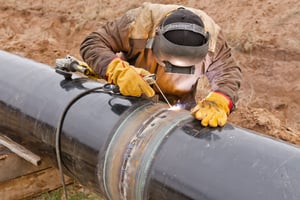
Need gloves? Well, if you work with your hands, there is a good chance you are going to need a pair of gloves or two. Should be simple enough, right? Jump online, buy some bulk at a good price. Done deal.
Yeah. Sure.
That's certainly one way to do it. Providing you have absolutely no concern about the glove actually protecting your hands. OK, OK… we get it. Time is money and you don’t have time to research every kind of safety glove on the market. Let's be real, there are quite a few. Here's a tip, click this orange button for help!
You also need to be in compliance with OSHA 1910.138
Remember that one? It states that hand protection must be worn when hands are exposed to hazards such as harmful substances, cuts, lacerations, and abrasions, chemical or thermal burns and extreme temperatures. And it falls on the employer to provide the right glove and material for the task.
Still not sure what you need? Have a hazard assessment performed and double check your Safety Data Sheets (SDS). For a quick, but detailed look at hand protection, be sure to watch this video. 
Here’s a little cheat sheet (shh… it’s our secret) on the different kinds of safety gloves and their applications:
Chemical Resistant: These safety gloves can be made of many different materials such as latex, nitrile, vinyl and neoprene. They offer the user chemical hand protection from toxic substances and depending on the material may offer protection against abrasion and puncture.
- Latex coated gloves have great elasticity and grip, excellent tear resistance, but not for use with hydrocarbon or organic solvents and may cause allergic reaction
- Nitrile/nitrile foam coated gloves offer resistance to cuts, abrasions, punctures, oils and fuels. Foam coating offers increased grip
- Polyurethane gloves work well with small parts; have excellent grip capability, resists oils, gasoline, grease, ozone and oxidation. Doesn’t stand up well to hot water
- Polyvinyl chloride (PVC) coated gloves work well with liquids and often offers slight chemical resistance. May also be used with abrasive materials that may be coated with grease and oil. Can be punctured, snagged and cut, however
Cut Resistant: These cut gloves are most often worn to protect the wearer from cuts when working with sharp tools or edges and are often coated. Cut resistant gloves can be made from metal mesh or cut-resistant materials, cut to shape and sewn into a glove or high performance materials that are knitted (seamless knitted gloves)
Disposable: Ideal for everyday tasks that require single-use (medical or food processing). Latex tends to offer natural chemical resistance to certain substances, better puncture resistance than vinyl, but can cause allergic reaction in some users
Drivers: Usually made out of various leather materials: cowhide, pigskin, goatskin or deerskin, these gloves help increase grip and control of steering wheel and gear stick. Some varieties may have padding in the palm for comfort
Electrical: These gloves offer insulation from accidental electrical contact. There are different varieties and they are categorized based on the levels of voltage protection and their resistance to ozone; so make sure you know the hazards and the level of protection your workers need!!
High Heat: When you need protection from high heat and welding applications, you need the right glove. High heat gloves typically offer increased palm and thumb protection, made with special materials designed to protect against high temperatures and are often sewn with a Kevlar® thread
String Knit: Made from materials such as cotton canvas, poly/cotton jersey, fleece cotton or terry cloth, these gloves offer protection in general applications such as warehousing, farming and automotive
Sleeves: These are the best way to extend protection from your safety glove in a variety of lengths for any task. Be sure to match the sleeve to your job, there are flame-resistant sleeves and even arc rated ones, as well as sleeves that provide a barrier to hazardous dry particles and light liquid splash
That’s not all! When selecting a chemical safety glove, take these things into consideration:
Breakthrough time: This is the amount of time from when a harmful chemical liquid makes contact with the outside of a glove or PPE and the time when it actually breaks the surface and touches skin
Degradation: This is a reduction in one or more protective properties of gloves or PPE due to contact with a chemical
Permeation: This is the process that a chemical can pass through a material's molecular structure without needing an access point (pinhole, pore or opening)
Save Money and Digits by Choosing the Right Glove the First Time!
There is a time and place for buying econo gloves. Working with sharp tools, chemicals or extreme temperatures is not it. That's like chasing nickels over dimes in the long run. So, with a little research you can match your safety equipment to the task and actually cut down your costs. There, that wasn’t so bad, was it? Still, lost? We're here to help.
Safety: It's Your Life, It's Our Business







